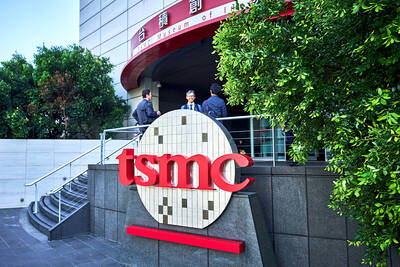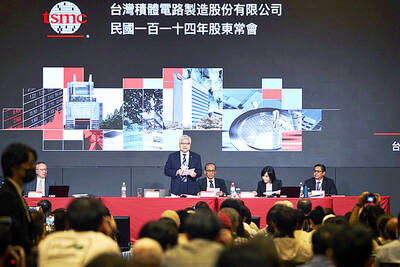Smartphone lens maker Largan Precision Co (大立光) is to proceed with its expansion plans, despite slowing growth in the global market, Largan chief executive officer Adam Lin (林恩平) told a teleconference with investors yesterday.
The company’s added capacity would be filled as smartphone designs continue to trend toward triple-camera configurations, sustaining demand for lenses, Lin said.
Concurrently, the company’s leading-edge seven-piece lenses began shipping at the end of last year, with many of them being used in triple-camera configurations, he said.
The company would refrain from taking orders with subpar profitability to fill expanded capacity, instead looking for viable opportunities in other high-end applications such as 3D sensing and in-display fingerprint sensing, he said.
“We are not concerned about price erosion,” Lin said.
As more smartphones adopt edge-to-edge screens, the complexity of front-facing camera units is to increase, as the units must also take on 3D sensing duties while conforming to smaller form factors, he said.
In light of slowing smartphone sales, Josephine Huang (黃印嘉), special assistant to Lin, said that the company’s inventory levels are still in a healthy range.
A newly developed product is expected to begin shipping toward the end of this year or early next year, Lin said, adding that the product was not made specific to a single customer and samples have been sent to multiple clients.
Revenue for this month is likely to remain little changed from last month, but is expected to dip next month due to disruptions from the Lunar New Year holiday, Lin said, adding that order cuts as a result of poor sales by its major clients led to the company’s poor showing last quarter.
However, smartphones remain the company’s priority, given the availability of orders for advanced automotive lens products, he said.
In the October-to-December quarter, the company reported net income dropped 22.6 percent quarterly to NT$6.48 billion (US$210.5 million), with revenue falling 23.81 percent to NT$12.44 billion.
Earnings per share (EPS) were NT$48.3 for the quarter, while gross margin fell 1.9 percentage points to 69.44 percent, it said.
For last year as a whole, net income fell 6 percent annually to NT$24.37 billion, with revenue dipping 6 percent to NT$49.95 billion. EPS were NT$181.68, down from NT$193.65 a year earlier, it said.

With an approval rating of just two percent, Peruvian President Dina Boluarte might be the world’s most unpopular leader, according to pollsters. Protests greeted her rise to power 29 months ago, and have marked her entire term — joined by assorted scandals, investigations, controversies and a surge in gang violence. The 63-year-old is the target of a dozen probes, including for her alleged failure to declare gifts of luxury jewels and watches, a scandal inevitably dubbed “Rolexgate.” She is also under the microscope for a two-week undeclared absence for nose surgery — which she insists was medical, not cosmetic — and is

CAUTIOUS RECOVERY: While the manufacturing sector returned to growth amid the US-China trade truce, firms remain wary as uncertainty clouds the outlook, the CIER said The local manufacturing sector returned to expansion last month, as the official purchasing managers’ index (PMI) rose 2.1 points to 51.0, driven by a temporary easing in US-China trade tensions, the Chung-Hua Institution for Economic Research (CIER, 中華經濟研究院) said yesterday. The PMI gauges the health of the manufacturing industry, with readings above 50 indicating expansion and those below 50 signaling contraction. “Firms are not as pessimistic as they were in April, but they remain far from optimistic,” CIER president Lien Hsien-ming (連賢明) said at a news conference. The full impact of US tariff decisions is unlikely to become clear until later this month

GROWING CONCERN: Some senior Trump administration officials opposed the UAE expansion over fears that another TSMC project could jeopardize its US investment Taiwan Semiconductor Manufacturing Co (TSMC, 台積電) is evaluating building an advanced production facility in the United Arab Emirates (UAE) and has discussed the possibility with officials in US President Donald Trump’s administration, people familiar with the matter said, in a potentially major bet on the Middle East that would only come to fruition with Washington’s approval. The company has had multiple meetings in the past few months with US Special Envoy to the Middle East Steve Witkoff and officials from MGX, an influential investment vehicle overseen by the UAE president’s brother, the people said. The conversations are a continuation of talks that

CHIP DUTIES: TSMC said it voiced its concerns to Washington about tariffs, telling the US commerce department that it wants ‘fair treatment’ to protect its competitiveness Taiwan Semiconductor Manufacturing Co (TSMC, 台積電) yesterday reiterated robust business prospects for this year as strong artificial intelligence (AI) chip demand from Nvidia Corp and other customers would absorb the impacts of US tariffs. “The impact of tariffs would be indirect, as the custom tax is the importers’ responsibility, not the exporters,” TSMC chairman and chief executive officer C.C. Wei (魏哲家) said at the chipmaker’s annual shareholders’ meeting in Hsinchu City. TSMC’s business could be affected if people become reluctant to buy electronics due to inflated prices, Wei said. In addition, the chipmaker has voiced its concern to the US Department of Commerce